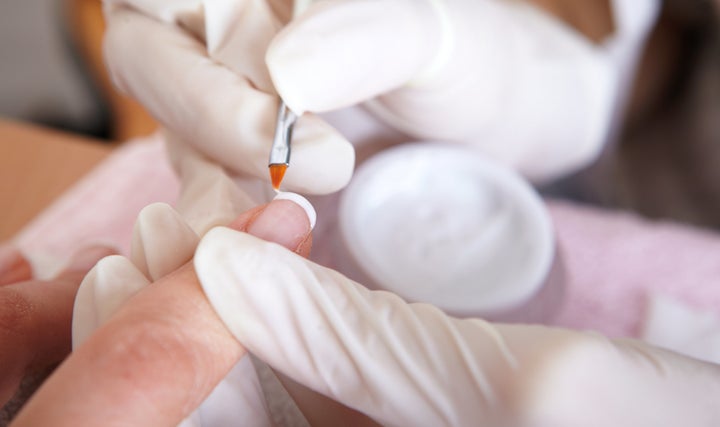Acrylic nails have been around for ages. Whether you sat down for the lengthy process to look picture perfect for your prom or to flaunt the perfect mani in a wedding party, these artificial nail enhancements are a rite of passage for so many women.
"Good-looking" nails aside, nail artist and industry expert Jessica Washick believes a lot of individuals still wear acrylics because they provide "a quick fix to achieve a temporary nail goal." This may include increasing strength, adding length or repairing splits or gaps. But at what cost to the overall health and condition of your nails?
We asked Washick and board-certified dermatologist/nail specialist Dana Stern to break down the potential hazards of acrylic nails. Read on to find out what we learned, and why you should probably reconsider getting acrylics the next time you're at the nail salon.

What exactly are acrylic nails?
According to Stern, acrylic nails are a combination of a liquid monomer and a powder polymer that creates a hard protective layer over your natural nails. She adds, "The acrylics harden from exposure to air. The material is transparent and a nail polish is applied after."
The acrylics will gradually grow out with your nails, and you will need to return to the salon or a nail professional in order to "fill" in the space. Keep in mind, this usually requires soaking your nails in acetone for 10-15 minutes in order to fully remove.
Are acrylics bad?
Dr. Stern told The Huffington Post that she generally isn't a fan of nail enhancements such as acrylics for several reasons:
Allergies to chemicals (resins and formaldehydes) in the product can cause nail separation, burning, pain or swelling. Not to mention, you may inhale significant and potentially harmful fumes if the salon isn't well-ventilated.
Acrylic nails are traditionally stiff, without any give. Nails are meant to have flexibility. Stern adds, "If the nail hits a hard object, it can more easily separate from the nail bed (onycholysis)."
Artificial nails may heighten risk of infection. "Bacteria that is not completely removed from a nail plate prior to the application of an enhancement can lead to Pseudomonas (bacteria that produces a green pigment, hence the term 'greenies') to grow in the space between the nail plate and the enhancement," says Stern. "Also, damaged nails that have areas of separation can predispose a salon-goer to this issue."
Are there healthier or safer alternatives to acrylic nails?
Stern believes there really are no healthy alternatives to adding a false "coat of armor" to your nails. Instead, she suggests taking a break from polish and acrylics in order to achieve strong, youthful nails.
When shopping for nail polishes that aren't loaded with harmful chemicals, Washick recommends those that are are free of resins and formaldehydes. "You'll usually be able to spot them because the product will boast something along the lines of "3-Free" or "5-Free." That means that those polishes are free from known harmful chemicals," she says.
Also On HuffPost: